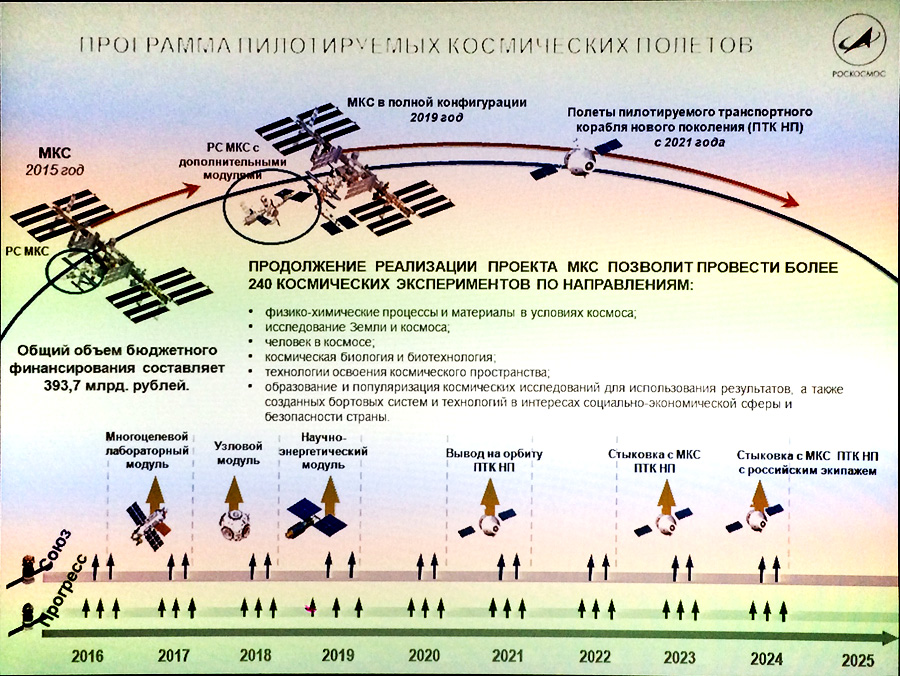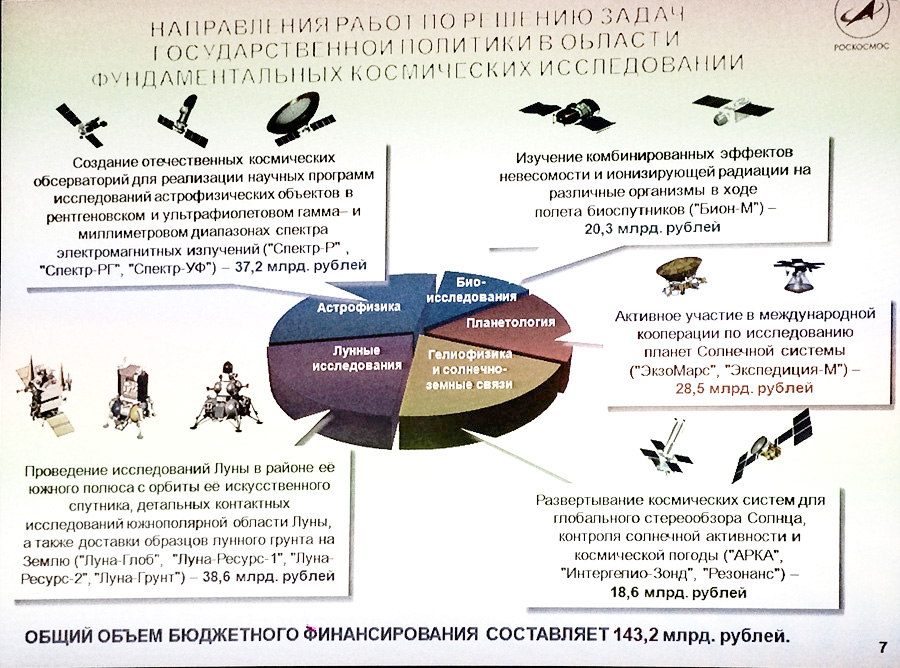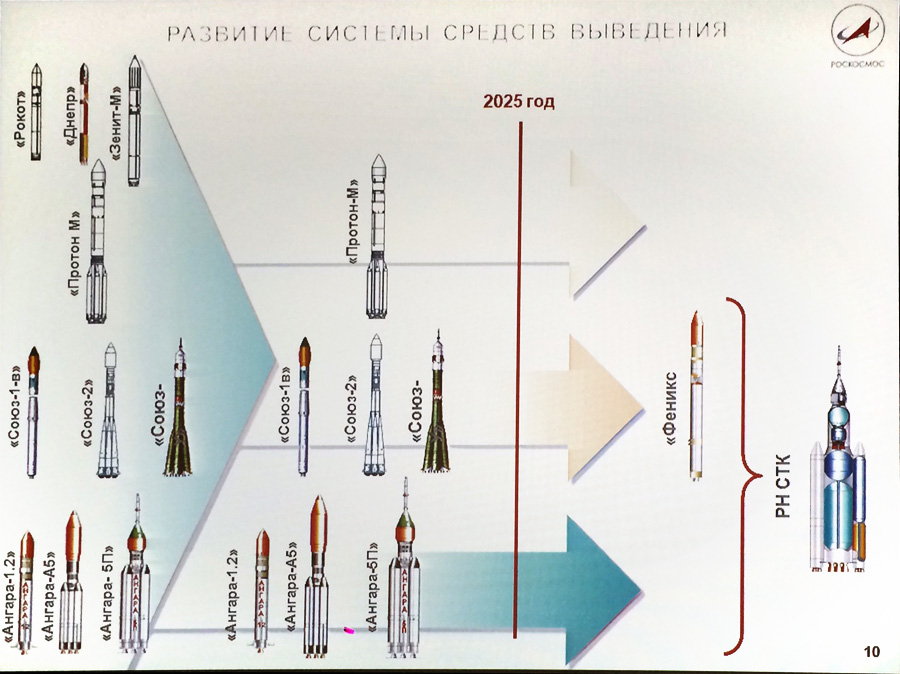Our space until 2025 and on

Photo: Ilya Pitalev / RIA Novosti
On Thursday, Roskosmos officially announced the details of the Federal Space Program for the next 10 years. Having succumbed to the March shame, I wrote a text in dark colors: everything was gone, the budget was cut, the plaster was taken off ... And then I saw the details of the program. And you know what? It's not so bad. Rather, even good, given the current situation. I had to re-write a report.
I remind you at once: to write and approve a program is not the same as implementing it. The adoption of the program itself turned out to be overdue for a year, and the fulfillment of all the goals set is a separate issue. But even if it is performed by two thirds, it will be a quite worthy ten-year-old Russian cosmonautics.
A bit of history:
At the end of 2014, Roskosmos immodestly counted on 2.8 trillion. rub. until 2025. All year long there was talk about the flight to the moon, then about our own space station. By the end of the year, oil began to fall down, people began to buy refrigerators, and conversations about flying to the moon gradually subsided. But the idea of building its own space station was still warm .
By early 2015, the economic and political situation was aggravated, in Roscosmosleadership changed , pressed ambitions and in April set a plan for 2 trillion. The ideology of the new leadership is based on the priority of the "national economic direction." They say that at first we will provide people with satellite imagery, navigation of centimeter accuracy, and broadband communication, then it is possible to aim at the moon.
The project, presented about a year ago, no longer had its own station and there was no super-heavy rocket, which the previous administration was talking about. Even the "Angara-A7" was canceled. On the other hand, the idea of manned achievement of the Moon by the four-launch Angaroy-A5B scheme was voiced. The difference from the usual "five", which once flew at the end of 2014, in an additional hydrogen stage. While there is no "A5B" new manned ship "Federation" if it will fly, then low - in low earth orbit. The goal was formulated elegantly: "To ensure the readiness of the flight to the moon by 2029." Those. it seems they should be able to, but still we will think whether to fly.
By the end of 2015, it became clear that the country does not have two trillions of space. There is only 1.4 trillion.,
For nearly half a year, the new leadership tried to divide one and a half trillion into consumers, for whom the two were not enough. At the same time, Roskosmos was reorganized, it was reborn from the Federal Space Agency to the State Corporation, all this took time. Finally, on March 17, 2016, the Government of the Russian Federation approved the Federal Space Program until 2025.
Surprisingly, not so many projects were cut off.
As promised, a lot of attention is paid to remote sensing of the Earth. By the year 2025, annually updated maps of Russia with a resolution of 0.5 m promise. Yes, this is already in Google and Yandex, but foreign satellites have been picking them up, but they will have their own.

They promise to bring this data to the world market, at a reasonable price and with high quality - this is a good and long time ago, although no one expects satellites to recoup.
They didn’t say much about the connection, the most interesting thing is that their own low-orbit telecommunications grouping for inter-machine communication will appear: what is called M2M telematics in business and the Internet of Things in the media.
Meteorology promises 98% coverage of the Earth, which means three geostationary " Electro-L ", over the Indian, Pacific and Atlantic oceans. Unfortunately, the Arctic project was postponed to the future - this is an analogue of Electro-L in the Molniya orbit - oh, there would be beautiful videos.
The manned program is described in detail. Soyuz and Progress fly like a clock, the Russian segment of the International Space Station is expanding, and the Federation begins flights. Here you can see the contribution of RSC Energia, whose new leader, Vladimir Solntsev, regularly and willingly gives interviews to one more optimistic than the other. But then he is not much different from his predecessors .
But in any case, it is clear that RSC Energia will live well in the next ten years. Probably the best in the industry, as in general it has always been.

Previously, information emerged that a key point of the MKS program fell out of the PCF: the Russian Energy Module. Without it, attempts to separate the Russian module and send the station to independent navigation are unthinkable. Politicians love to play at this, and, to their joy, the module remained in the program. However, the date of its launch - the 2018th year looks sooo optimistic. On the other hand, it makes little sense to postpone its launch later - in 2024, the ISS program is completed entirely. Of course, the tempting idea is not to drown one’s own part, but to continue to keep it in orbit, but not a word was said at the press conference. And it is right, because experts, unlike politicians, understand that the resource of the current modules is not unlimited. Some are already flying longer than Mira, and in ten years they will never be able to become part of the actually new station.
In reality, by that time it will be easier to build a new station from scratch, and this has already been discussed at a meeting with the press. It was emphasized that they want to do the new station again in cooperation, they talked about NASA and ESA, they subtly hinted at India. Mentioned new approaches and technologies, read: inflatable modules and carbon fiber hulls. They also mentioned the station near the Moon, and the lunar base, but not as plans, but rather as landmarks for world cosmonautics for the future.
Expenditures for scientific research have planned 146 billion rubles, i.e. about 10% of the total budget. The program includes almost all the projects that were inherited from the previous program. Probably, only biosatellites were added, and research into asteroids fell off, even the Chelyabinsk meteorite did not help.

Such a wide fleet of projects, with fairly modest funding (less than one Curiosity rover) suggests that it is not by chance that the launch dates are not shown on the slide. Those. what is indicated in the heading is here: “directions of work”, and not “implementation”. In this case, you can honestly continue working for ten years or more. I asked: "But will everything fly to 2025?" and received the answer: “Exactly!”, unfortunately this question was not included in the press conference recording.
Let me assume that the head of Roskosmos was wrongly informed when they promised to fly all this abundance for 10 years. Earlier in the press it was repeatedly mentioned that the projects "Spectr-M" and "Interheliozond" moved to the 30s. It sounds more convincing.
There are doubts that the allocated amount will suffice for all the tasks indicated. Although there certainly will be part of the partnership projects. For example, the Spectrum-WG carries a German telescope. One of the five lunar stations will be shared with Europeans. Most likely, the mysterious "Expedition-M" will become the Russian-European project for the delivery of soil from Phobos or Mars. If ExoMars-2018 is successfully planted, then so be it. Maybe they will come to an agreement with Interheliozond ...
The biggest doubt, both on the unmanned and manned program, is meeting the deadlines. Former Roscosmos all their debris. Whether the present and future Roscosmos can be corrected is a big question. If I can handle it, I will believe in miracles for the second time in my life.
An interesting picture of rockets.

The most important thing: Roskosmos has decided on the development strategy of the rocket park - this is really a big and important matter. “Angara” remains the default, and the legendary “Unions” and “Protons” should be replaced with the mysterious “Phoenix” after the 25th year.
In fact, “Phoenix” is a reborn “Zenith”, in which there is no Ukrainian participation. “Zenith” predicted a great future as early as the 80s, even then it was considered as a new stage, replacing “Unions” and “Protons”, and here is a new attempt. Simultaneously with the fact that this should be a modern rocket, it will be able to become part of the project of an extra heavy rocket in the future. Just like in the 80s, Zenit was part of the Energy project.
The funny thing is that this is almost a complete copy of the development concept of the Falcon-9 from SpaceX. But it’s already hard to say who borrowed from whom, rather it’s just a demonstration of the most optimal development scheme for rocket technology. That is characteristic, about a reusability no one even stutters. There is no such priority in the Russian ten-year program. Private astronautics, by the way, is also not provided.
The only question is - who came up with the name “Phoenix”. The logic of rebirth is understandable, but the word is generally contrary to the entire tradition of the names of missiles in the national cosmonautics. Then they would call Finist, perhaps a word from the Russian language.
Separate attention is worth the discussion between the head of Roskosmos and one of the journalists, who demanded to immediately begin the production of extra-heavy rocket. The arguments of the journalist:The Americans are building SLS and Ares [the Ares project was closed in 2010], and such a rocket can be useful to our military .
After Komarov’s phrase: “ Now the military has no such loads, and I really hope that there will never be a need for them ... ” I just wanted to shake hands with him as a human being.
Super Heavyweight Discussion 1:23:45
In general, in the plans, we have a very good cosmonautics. Without caps, pragmatic and balanced. I’ll just remind all fans of space racing: the Roscosmos ten-year budget is as much as NASA gets for a year.
And I again had the feeling that Komarov was the best thing that had happened to Roscosmos over the past 10 years, or even more. In my opinion, a person has fallen into his place, and while he is trying, you can be calm for the future of Roskosmos.
